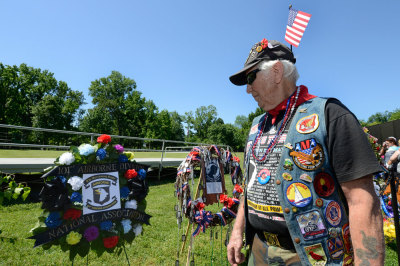Suicide Takes 22 Soldiers a Day: What Can We Do?

American soldiers are "bringing the war home": 22 veterans and one active duty soldier are said to commit suicide every day. Some estimate that more than 30 lives are lost every day.
According to Stop Soldier Suicide, veterans commit suicide at a rate two to three times higher than civilians.
Post-traumatic stress disorder (PTSD) is diagnosed in about 15 percent of soldiers, and may drive them to end their lives. Many more probably suffer from PTSD in silence, fearing that the stigma may end their career or keep them from finding any gainful employment.
What a tragedy and scandal it is for America to send its strongest, bravest, most dedicated, and most capable young people off to war—and then abandon them when they come home! How many spend years alone in a dark room, or wander homeless, or become addicted to drugs or alcohol? Maybe they don't commit suicide—but their lives as a member of their family and society may be over or blighted.
Since World War I, there has been a perception that PTSD—"shell shock" as it was known then—is a sign of mental weakness, or of not having the "right stuff." The manifestations resemble psychiatric illness: sleeplessness, nightmares, flashbacks, inability to concentrate, irritability, and inability to control impulses. Veterans may get little sympathy—they have not lost a limb, they may have no visible scars, they may not even have had a concussion or loss of consciousness. Their brain CT scan or MRI may be completely normal.
If they are able to get into a VA treatment program, they will probably receive drugs: anti-depressants, anti-psychotics, perhaps opioids. While there is little to no evidence that this treatment helps, it does generally carry an FDA "black box" warning—of increased risk of suicide.
What can we do?
We could start by making the right diagnosis. Many of these veterans have an unrecognized traumatic brain injury (TBI), either causing or complicating their PTSD. The mechanism was elucidated, if not widely acknowledged, in the early 1900s. Explosions create a blast wave, whether from an improvised explosive device (IED) or from firing high-powered ammunition. As might be predicted, the more firefights a soldier is in, the greater the risk of TBI/PTSD.
High pressure, followed by low pressure—this also happens when SCUBA diving and surfacing too fast, or when rapidly climbing to high altitude in an aircraft. With an IED, the process just happens faster—but not too fast for bubbles to form in the blood. Yes, they have been seen and photographed.
Our soldiers are repeatedly subjected to neurological decompression injury—the "bends." And what happens when they are rapidly evacuated by air, as opposed to staying on the ground for weeks as in Viet Nam? They "crash" (rapidly deteriorate) in flight. If you have taken SCUBA diving instruction, you know you're not supposed to fly too soon after diving.
How do we treat the bends? In a hyperbaric (high pressure) chamber. Do we have such things in war zones? We sent about 15 to the Gulf, but only unpacked one, which was used to treat some divers.
But isn't it too late to treat veterans? It is not. TBI and many other neurologic injuries, including stroke, may benefit greatly from a series of treatments at extremely safe pressures, about 1.5 atmospheres, even years later. Hundreds of veterans have been treated in private centers, often reporting relief of constant headaches and insomnia after just a few sessions.
Can they get this at the VA? No. The VA will not tell them about it, and may even discourage it. Is the VA afraid that it might not work? Reportedly, knowledgeable persons know that it does—but fear that making it available would "bankrupt the system." At $3,000 per session charged by hospitals, it might. But freestanding centers charge more like $150, and some offer pro bono treatment to veterans. And what is the life of a 20-year-old veteran worth?
To commemorate soldiers and to inform the public about how hyperbaric oxygenation (HBOT) can help, nonprofit groups such as Healing Arizona Veterans will plant 22 white crosses at "cemeteries" around the country on September 18.



























